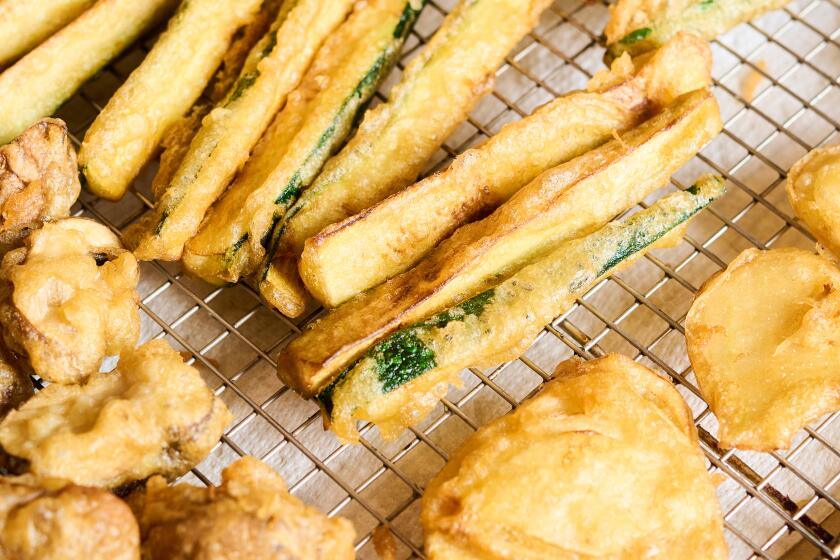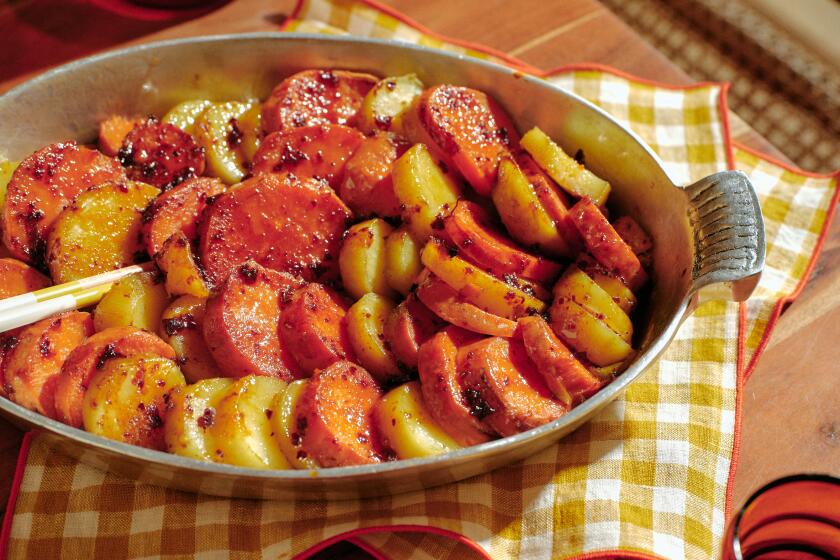Roasted carrots
- Share via
My neighbor Robert, who shops only at farmers markets for his fruit and vegetables, is one of the best home cooks I know. He’s never been a recipe sort of a guy, instead improvising in his tiny Santa Monica kitchen to make great dishes out of those fresh romano beans, that pile of purple potatoes or those fat spears of asparagus.
More often than not, the musician-cum-cook is riffing off the advice of a farmer. Without fail, Robert chats with growers when he goes shopping.
Do the same and you’ll get to know your vegetables so well you might not need a recipe either. If a farmer says you can use green garlic just as you would mature garlic, using just the white and pale green parts, then you’ve got inspiration for a new dish right there.
But sometimes you just want a recipe to tell you exactly what to do. With that in mind, we visited the Santa Monica Wednesday market and asked growers what they like to make using their own produce -- and how.
These recipes use the best foods in season now, and in some cases reveal the great dynamic between farmers and cooks. Farmers might tell customers a thing or two about that new leafy green, but inspired chefs and innovative home cooks also tell farmers about the neat things they’re doing with their produce. And all those ideas travel from the stall to the kitchen, and back and forth again.
Take the recipe for roasted carrots from Maryann Carpenter of Coastal Organics. “I had never roasted anything before,” she says, but “ever since we started doing a lot of business with chefs, they roast everything. It’s such a great way to do vegetables. I do asparagus, beets, summer squashes, cauliflower -- practically every vegetable now I roast.” And the technique works particularly well with carrots.
Royal Scarlets are new this year from Coastal, which farms 15 acres in Santa Paula; they’re especially sweet out of the oven. In fact, this is the best way to have them, says Carpenter, an avid cook. “Some of these new varieties are not very tasty raw, but once you roast them, they’re really fabulous.... They’re like a whole different vegetable when cooked.”
For her recipe, you can use any variety of farm-fresh carrots, but we found it especially wonderful with an assortment. When roasted, the orange Nantes, yellow Sugar Crisps, white Belgium Whites, pink Nutri-pinks and purple Royal Scarlets differed not only in color, but also in flavor and texture. They made this simple dish so much fun, evoking other vegetables after roasting. The Sugar Crisps reminded us of sweet potatoes, for instance, dense and almost starchy, while the Belgian whites were like tender-crisp turnips.
At Coleman Family Farms’ stall, Bill and Delia Coleman started displaying recipes a decade ago, sometimes even handing out copies. “I got too busy to tell people over and over,” Bill Coleman says. And sure enough, he later handed me a pile of recipes, some typed and copied, others scribbled on a notepad.
One was an intriguing pesto calling for three bunches of nasturtium in place of the traditional basil, plus a chunk of Parmesan and some olive oil. It might seem cruel to put the gorgeous orange and golden yellow flowers into a food processor, so spare a couple of these beauties for garnish later. The flowers turn into a red-orange puree, obliterating any evidence of the pretty petals but for the unmistakable taste of nasturtiums: fresh, sharp and peppery, complementing the salty bite of the cheese. It’s a treat slathered on thin baguette slices toasted in the oven.
Delia Coleman, who often handles the floral end of the stand, said she got the recipe idea from a regular customer who’s always asking after interesting ingredients -- not a difficult request at the Colemans’ stand. Take a look at the herbs, for instance, and nestled among the basil, the thyme and the parsley, you’ll find bunches of exotic fenugreek.
The Colemans’ daughter, Ligaya, came up with a warm fenugreek salad, which balances the bitterness of the blanched herb with other strong flavors such as cilantro and cumin. The result is a side dish featuring curry flavors.
Fenugreek will be around for at least a few more weeks (until the weather turns too hot). Likewise, there are only a few precious weeks left for fava beans. Happily, though, they’ll still be around for the start of corn season. Paul Thurston, a manager for McGrath Farms, likes to combine these two in a salad with a lemon vinaigrette and cilantro.
“They’re two flavors that work well together,” says Thurston, who before joining the Oxnard farm a dozen years ago cooked at the Delancey Street Restaurant in San Francisco. “None of the tastes are overbearing.”
The salad is a little labor-intensive and time-consuming, considering the shelling, blanching, then hulling of the favas. But it’s well worth the effort. Besides, this is a once-a-year opportunity to make a dish that captures the fresh flavors of spring and summer.
For a sweet taste of the season, we checked in with Harry’s Berries. Molly Gean didn’t hesitate when asked for a recipe. “My sister-in-law’s strawberry pie. It deserves to be famous.”
And indeed it does. The pie is a mountain of luscious whole berries capped with snowy peaks of whipped cream. The glaze that holds the fruit together is full of strawberry flavor because it’s made from pureed berries.
Gean’s sister-in-law, Yoshiko Iwamoto, has been making this pie for more than 20 years, tinkering until it was practically foolproof. Just follow the recipe to the letter.
Iwamoto, who handles the farm’s bookkeeping and works in food service for the Oxnard school district, saves the pie for special occasions. Last season, though, when a customer-appreciation day drew hundreds of people to the farm, pie seemed too labor-intensive.
And so “strawberry pie shortcake” was born. “We made the filling and served it in shortcakes,” says Gean, whose father, the late Harry Iwamoto, started Harry’s Berries in the 1960s. Today, her husband, Rick, and brother, Kaz Iwamoto, do the farming on about 30 acres in Oxnard. They grow a variety of produce such as tomatoes and green beans on half the land; the other half is devoted to strawberries.
Right now, you’ll find pints of Gaviotas and Seascapes blanketing Harry’s Berries stalls. If you’re making this pie -- or any dessert with added sugar, for that matter -- choose the more acidic Seascapes, Yoshiko Iwamoto advises.
If you want strawberries straight out of the punnet, as I did recently, the sweeter Gaviotas are terrific.
That’s what Ken Iwamoto, Yoshiko’s son, told me when I couldn’t decide. He was right. And what easier farmer’s recipe is there than rinse, dry and serve?
Heat the oven to 400 degrees. Wash and trim the carrots. Peeling is optional. If the carrots are baby size, leave them whole. Cut larger carrots into chunks or thick slices (carrots shrink when cooking).
On a foil-lined baking sheet, toss the carrots with the olive oil. Arrange the carrots in a single layer and sprinkle with salt and pepper.
Roast uncovered until tender when pierced with a knife, about 20 minutes (depending on the size of the pieces), shaking the pan occasionally to turn the carrots.
Sprinkle with the chopped parsley and serve.
Get our Cooking newsletter.
Your roundup of inspiring recipes and kitchen tricks.
You may occasionally receive promotional content from the Los Angeles Times.















